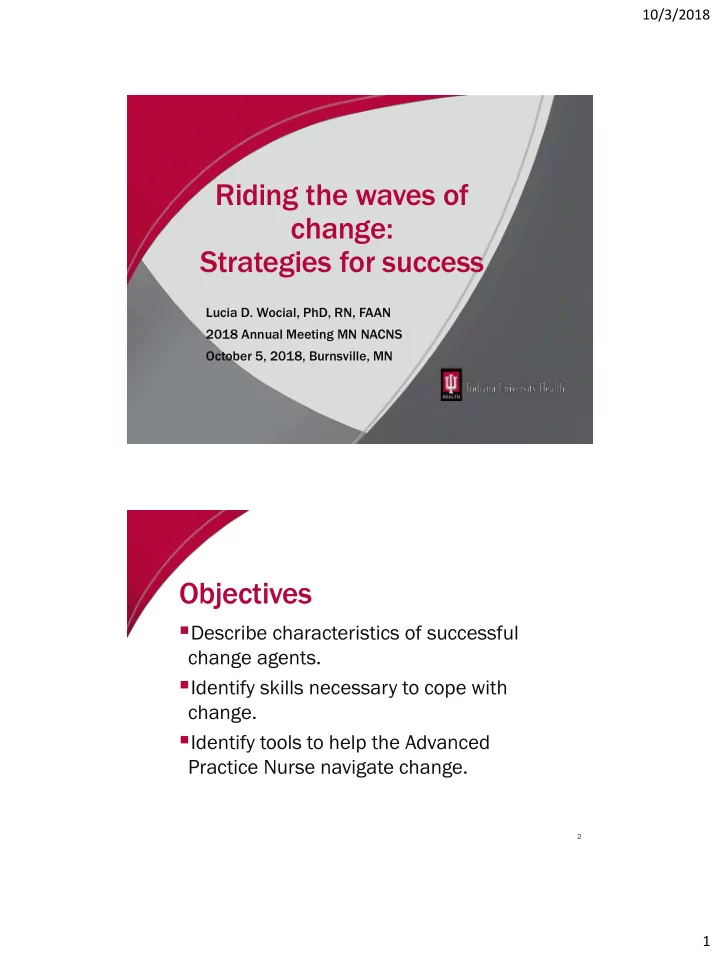

10/3/2018 Riding the waves of change: Strategies for success Lucia D. Wocial, PhD, RN, FAAN 2018 Annual Meeting MN NACNS October 5, 2018, Burnsville, MN Objectives Describe characteristics of successful change agents. Identify skills necessary to cope with change. Identify tools to help the Advanced Practice Nurse navigate change. 2 1
10/3/2018 Diffusion of Innovation Curve early late number of people majority majority early adopters resisters innovators 2% 15% 34% 34% 17% length of time to adopt innovation Rogers, 2005 3 4 2
10/3/2018 Change vs Transition Change Transition 5 Transition Modal Neutral Ending Beginning Zone 6 Bridges, 1995 3
10/3/2018 The Change Agent: Characteristics 7 Personal Characteristics Persistence Sense of Humor Tough Skin Patience optimism 8 4
10/3/2018 Resilience A dynamic capability which can allow people to thrive on challenges given appropriate social and personal contexts. Howe, Smajdor & Stockl, 2012 “the ability to recover or healthfully adapt to challenges, stress, adversity, or trauma: to be buoyant in adverse circumstances .” Rushton, 2016 Features of resilience Self-efficacy Self-control Ability to engage support and help Learning from difficulties Persistence despite blocks to progress Howe, Smajdor & Stockl, 2012 5
10/3/2018 Enhancing personal resilience Accept change Continue learning Sense of purpose Personal identity Networking Reflection Learn new skills 11 Code of Ethics for Nurses 1. Practice with compassion and respect. 2. Primary commitment is to patient. 3. Advocate for individuals. 4. Accountable for individual nursing practice 5. 5. The nurse se owe owes s the same e duty ty to self 6. Establish and improves health care environments. 7. Advance the profession through development. 8. Collaborate with others to meet health needs. 9. Articulate values and maintain integrity of nursing 12 6
10/3/2018 13 The Change Agent: Skills and Resources 14 7
10/3/2018 The Change Agent: Job Description Coach Role Model Navigator Teamwork: Cast of Characters Sponsor Advocate Change Agent The Team 16 8
10/3/2018 Leadership Characteristics Character Commitment Connectedness Compassion Confidence Five Modes of Conflict Management Accommodating Collaborating Cooperation Compromising Avoiding Competing Assertiveness http://www.foundationcoalition.org/teams 9
10/3/2018 Silence is not golden Silence Kills. The Seven Crucial Conversations for Healthcare. 2005 The Silent Treatment: Safety tools and checklists aren’t enough, 2010 19 Crucial Conversations Broken rules (shortcuts) Disrespect Incompetence Lack of support Micromanagement Mistakes Poor teamwork Patterson, Grenny, McMillin, and Switzler, (2002) 10
10/3/2018 Accountability Ladder Making Things Happen Healthy Planning Problem Solving Curious/Learning Moaning and Groaning Blaming Avoiding Unhealthy Denial Sabotage 21 Tools to Navigate Change 22 11
10/3/2018 Eight Steps of Successful Change 8. Create a New Culture 7. Don’t Let Up 6. Produce Short-Term Wins 5. Empower Others to Act focus 4. Communicate for Understanding & Buy-In 3. Develop the Change Vision and Strategy 2. Pull Together the Guiding Team 1. Create a Sense of Urgency 2 Kotter, 2007 3 Universal Precautions Gloves: set realistic expectations Gown: seek help when necessary Goggles: explore excuses 12
10/3/2018 Checklist for staying on track Change Compo ponents Outcome Vision Confusion Skills Anxiety Incentives Gradual Change Resources Frustration Action Plan False Starts ALL Change Lippitt, 1987 25 Riding the wave Focus on shared SMART goals Specific, measurable, achievable, relevant, time-based Start small prioritize often Give positive feedback 13
10/3/2018 3 Communication Channels Channel el Meanin ing Tool ol Affective Emotion NURSE Cognitive Facts Ask-Tell-Ask Meaning What I wish, I matters worry 27 Listening: An Exercise I’m fed up with this. I can’t get my work done on the new computer system. I know we can’t go back to our old system (which is a shame) but there’s got to be a better way. I’ve got some ideas about how to make this thing work, but I’m not sure it’s worth investing my time and energy. 28 14
10/3/2018 PAUSE Breathe Smile Stand up straight Release muscle tension focus 29 Mental Training Identify the central issue Validate your reaction Weigh the importance What can YOU do about it? Say what? 30 15
10/3/2018 How to Survive Self-care Support network Safe space Acceptance Lighten up Seek inspiration Riding the wave… Nurture supportive relationships Manage conflict Engage in difficult conversations 16
10/3/2018 33 Comments/Questions? lwocial@iuhealth.org 34 17
10/3/2018 References Bridges, W., & Mitchell, S. (2000). Leading transition: A new model for change. Leader to leader , 16 (3), 30- 36. Crownover, B. (2003). Why did that idea flop?. Family practice management , 10 (8), 39. Howe A1, Smajdor A, Stöckl A. Towards an understanding of resilience and its relevance to medical training. Med Educ. 2012 Apr;46(4):349-56. doi: 10.1111/j.1365-2923.2011.04188.x. Hutton, D. W. (1994). The change agents' handbook: A survival guide for quality improvement champions . ASQ Quality Press. Kaminski, J. (2011). Diffusion of innovation theory. Canadian Journal of Nursing Informatics , 6 (2), 1-6. Kotier, J. P. (1995). Leading change: why transformation efforts fail. Harvard Business Review , 73 (2), 59-67. Lippitt, M. (1987). Leading Complex Change. Enterprise Management, Ltd. Peter, E and Liaschenko, J. “Moral Distress Reexamined: A Feminist Interpretation of Nurses’ Identities, Relationships, and Responsibilities,” Journal of Bioethical Inquiry 10, no. 3 (2013): 337 -45. Pulley, M. L., & Wakefield, M. (2001). Building resiliency: How to thrive in times of change . Center for Creative Leadership. Rogers, E. (2003). Diffusion of Innovations. Fifth edition. Free Press: New York. Rushton CH, Carse A. Towards a New Narrative of Moral Distress: Realizing the Potential of Resilience. J Clin Ethics. 2016 Fall;27(3):214-218. Silence kills: The seven crucial conversations for healthcare . (2005). VitalSmarts. Retrieved from http://www.aacn.org/WD/Practice/Docs/PublicPolicy/SilenceKills.pdf The silent treatment: Why safety tools and checklists aren’t enough to save lives . (2011). VitalSmarts. http://silenttreatmentstudy.com/ 35 18
Recommend
More recommend